
Solanum dulcamara is a species of vine in the genus Solanum of the family Solanaceae. Common names include bittersweet, bittersweet nightshade, bitter nightshade, blue bindweed, Amara Dulcis, climbing nightshade, felonwort, fellenwort, felonwood, poisonberry, poisonflower, scarlet berry, snakeberry, trailing bittersweet, trailing nightshade, violet bloom, and woody nightshade.
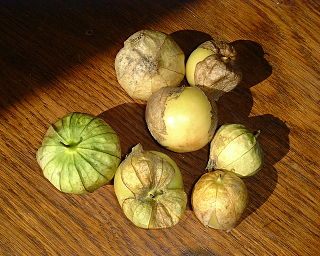
The tomatillo, also known as the Mexican husk tomato, is a plant of the nightshade family bearing small, spherical, and green or green-purple fruit of the same name. Tomatillos originated in Mexico and were cultivated in the pre-Columbian era. A staple of Mexican cuisine, they are eaten raw and cooked in a variety of dishes, particularly salsa verde. The tomatillo is a perennial plant but is generally grown for agriculture each year as if it were an annual.

Physalis is a genus of approximately 75 to 90 flowering plants in the nightshade family (Solanaceae), which are native to the Americas and Australasia. At least 46 species are endemic to Mexico. Cultivated and weedy species have been introduced worldwide. A defining feature of Physalis is a large, papery husk derived from the calyx, which partly or fully encloses the fruit. Many species bear edible fruit, and some species are cultivated.
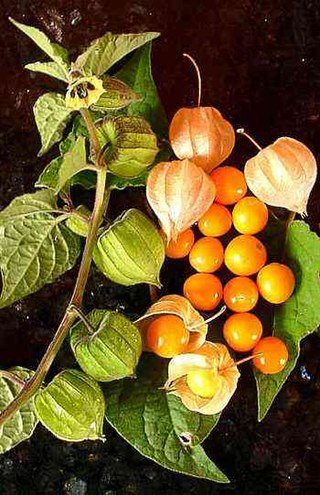
Physalis peruviana is a species of plant in the nightshade family (Solanaceae) native to Chile and Peru. Within that region, it is called aguaymanto, uvilla or uchuva, in addition to numerous indigenous and regional names. In English, its common names include Cape gooseberry, goldenberry and Peruvian groundcherry.

Physalis angulata is an erect herbaceous annual plant belonging to the nightshade family Solanaceae. Its leaves are dark green and roughly oval, often with tooth shapes around the edge. The flowers are five-sided and pale yellow; the yellow-orange fruits are borne inside a balloon-like calyx. It is native to the Americas, but is now widely distributed and naturalized in tropical and subtropical regions worldwide.

Nicandra physalodes is a species of flowering plant in subfamily Solanoideae of the nightshade family. It is known by the common names apple-of-Peru and shoo-fly plant. It is thought originally to have been native to western South America, including Peru, and is known elsewhere as an introduced and ruderal species – sometimes as a weed – in tropical, subtropical and, to a lesser extent, temperate areas all over the world. It has also long been cultivated as an ornamental plant for its attractive flowers and curious fruits and has been adopted into the traditional medicine of countries far-removed from its original home.
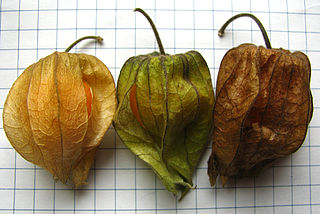
Physalis heterophylla, colloquial name clammy groundcherry, is species of herbaceous plant in the family Solanaceae. It is native to North America, occurring primarily in the eastern United States and Canada. It is known to occur in all contiguous states except for Nevada and California. It is found mainly in habitats such as dry or mesic prairies, gravel hills and rises, sandy or rocky soils, and waste places such as roadsides.

Physalis longifolia, known by the common names common groundcherry, longleaf groundcherry, and wild tomatillo, is a species of flowering plant in the nightshade family, Solanaceae. It is native to North America, where it is native to eastern Canada, much of the continental United States, and northern Mexico. It has also been noted as an introduced species in other regions, including parts of the United States outside its native range. In some areas, such as California, it is an occasional noxious weed.

Physalis acutifolia is a species of flowering plant in the nightshade family known by the common names sharpleaf groundcherry and Wright's ground-cherry. It is native to the southwestern United States from California to Texas, and northern Mexico, where it can be found in many types of habitat, including disturbed areas. It is sometimes a weed when it springs up in agricultural fields, but it is generally not weedy in wild habitat. This is an annual herb producing a branching stem up to a meter tall. The lance-shaped to oval leaves are up to 12 cm long and have edges lined with shallow, smooth teeth. The herbage is coated thinly in hairs appressed flat against the surface. The flowers growing from the leaf axils are round and flat-faced and sometimes over 2 cm wide. They are white to pale yellow with wide, bright yellow centers. The five stamens are each tipped with an anther about 3 mm long. The star-shaped calyx of sepals at the base of the flower enlarges as the fruit develops, becoming an inflated, ribbed lantern-shaped structure about 2 cm long which contains the berry.
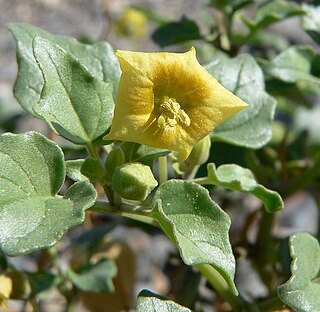
Physalis crassifolia is a species of flowering plant in the nightshade family known by the common names yellow nightshade groundcherry and thick-leaf ground-cherry. It is native to the southwestern United States and northern Mexico, where it can be found in rocky, dry desert and mountain habitat. This is a perennial herb producing a ridged, angular, branching stem approaching 80 cm long, taking a clumped, matted, or erect form. The fleshy oval leaves are 1 to 3 cm long and have smooth, wavy, or bluntly toothed edges. The herbage is glandular and coated in short hairs. The yellow flowers growing from the leaf axils are widely bell-shaped, vaguely five-lobed, and around 2 cm wide. The star-shaped calyx of sepals at the base of the flower enlarges as the fruit develops, becoming an inflated, angled lanternlike structure about 2 cm long, which contains the berry.
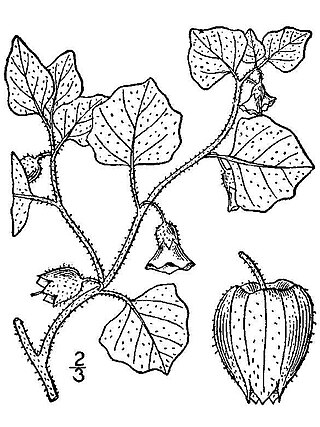
Physalis hederifolia is a species of flowering plant in the nightshade family known by the common name ivyleaf groundcherry. It is native to the southwestern United States and northern Mexico, where it can be found in rocky, dry desert and mountain habitat. This is a rhizomatous perennial herb producing a hairy, branching stem 10 to 80 centimeters long. The gray-green oval leaves are 2 to 4 centimeters long and have smooth or bluntly toothed edges. The flowers growing from the leaf axils are bell-shaped and just over a centimeter long. They are yellow with five brown smudges in the throats. The five-lobed calyx of sepals at the base of the flower enlarges as the fruit develops, becoming an inflated, veined nearly spherical structure 2 or 3 centimeters long which contains the berry.
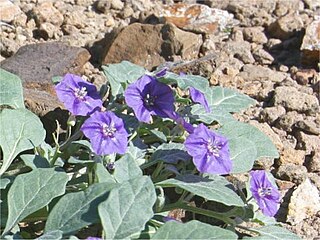
Quincula is a monotypic genus of flowering plants in the nightshade family, Solanaceae. The sole species it contains, Quincula lobata, is commonly known as Chinese lantern, lobed groundcherry, or purple groundcherry.

Physalis pubescens is a species of flowering plant in the nightshade family known by many common names, including husk tomato, low ground-cherry and hairy groundcherry in English, and muyaca and capulí in Spanish. It is native to the Americas, including the southern half of the United States, Mexico, Central and much of South America. It can be found elsewhere as an introduced species and sometimes a weed. It can grow in many types of habitat, including disturbed areas. This is an annual herb producing a glandular, densely hairy stem up to about 60 cm (24 in) in maximum height from a taproot. The oval or heart-shaped leaves are 3–9 cm (1.2–3.5 in) long and have smooth or toothed edges. The flowers blooming from the leaf axils are bell-shaped and about a centimeter long. They are yellow with five dark spots in the throats, and have five stamens tipped with blue anthers. The five-lobed calyx of sepals at the base of the flower enlarges as the fruit develops, becoming an inflated, ribbed, lanternlike structure 2–4 cm (0.79–1.57 in) long which contains the berry.

Physalis viscosa is a species of flowering plant in the nightshade family known by many common names, including starhair groundcherry, stellate ground-cherry and grape groundcherry in English, and arrebenta-cavalo, balãozinho, and camambú in Portuguese and Spanish. It is native to South America, and it is known on other continents as an introduced species and sometimes a weed. It can grow in many types of habitat, including disturbed areas.

Solanum triflorum is a species of nightshade, in the family Solanaceae, also known as cutleaf nightshade and small nightshade. Like many nightshades, S. triflorum is native to South America, specifically to Argentina; it has made its way onto other continents, including Europe and Australia, as an introduced species, where it is deemed a weed, at times. It is present throughout much of North America, where it also not native. It grows in many types of habitats, preferring tilled, disturbed terrain for germinating. It is an annual herb, producing sprawling, decumbent stems dotted with new growth. These decumbent, horizontal stems may quickly grow up to a meter in all directions. Solanum triflorum is covered in trichomes and hairs, which are sometimes mistaken for glands. The leaves are a few centimeters long, and deeply “cut” into slightly pointed, serrated lobes, garnering its common name, “cutleaf”. The inflorescence bears two or three flowers, each just under a centimeter wide when fully open. The flower is usually white, but may be greenish or purple-tinged. The fruit is a berry, similar to the nightshade family, roughly a centimeter wide.
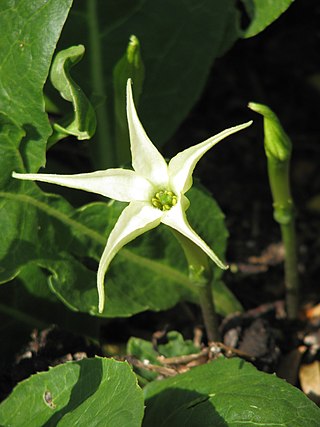
Jaborosa is a genus of flowering plants in the family Solanaceae, the nightshades. There are about 23 species, all native to South America, where they are distributed from Peru to Patagonia. Most occur in the Andes. Most can be found in Argentina and ten are endemic to the country.

The Solanaceae, or the nightshades, are a family of flowering plants that ranges from annual and perennial herbs to vines, lianas, epiphytes, shrubs, and trees, and includes a number of agricultural crops, medicinal plants, spices, weeds, and ornamentals. Many members of the family contain potent alkaloids, and some are highly toxic, but many—including tomatoes, potatoes, eggplant, bell and chili peppers—are used as food. The family belongs to the order Solanales, in the asterid group and class Magnoliopsida (dicotyledons). The Solanaceae consists of about 98 genera and some 2,700 species, with a great diversity of habitats, morphology and ecology.
Calliphysalis carpenteri, or Carpenter's groundcherry, is a perennial plant in the family Solanaceae, the "nightshade" plants. Native to sandy soils on the coastal plain regions of southeastern North America from northern Florida to Louisiana and Arkansas, it was first described from specimens collected in West Feliciana Parish, Louisiana. Its species name honors the botanical contributions of early Louisiana naturalist William Marbury Carpenter (1811-1848).

Physalis walteri, commonly known as Walter's groundcherry or dune groundcherry, is a species of flowering plant. Its native distribution is Alabama, Florida, Georgia and Virginia in the United States as well as Northeast Mexico. Its habitat is pinelands and open coastal areas.

Alkekengi officinarum, the bladder cherry, Chinese lantern, Japanese-lantern, strawberry groundcherry, winter cherry, or Klabuster cherry is a species of flowering plant in the nightshade family Solanaceae. It is a close relative of the new world Calliphysalis carpenteri and a somewhat more distant relative to the members of the Physalis genus. This species is native to the regions covering Southern Europe to South Asia and Northeast Asia.


















